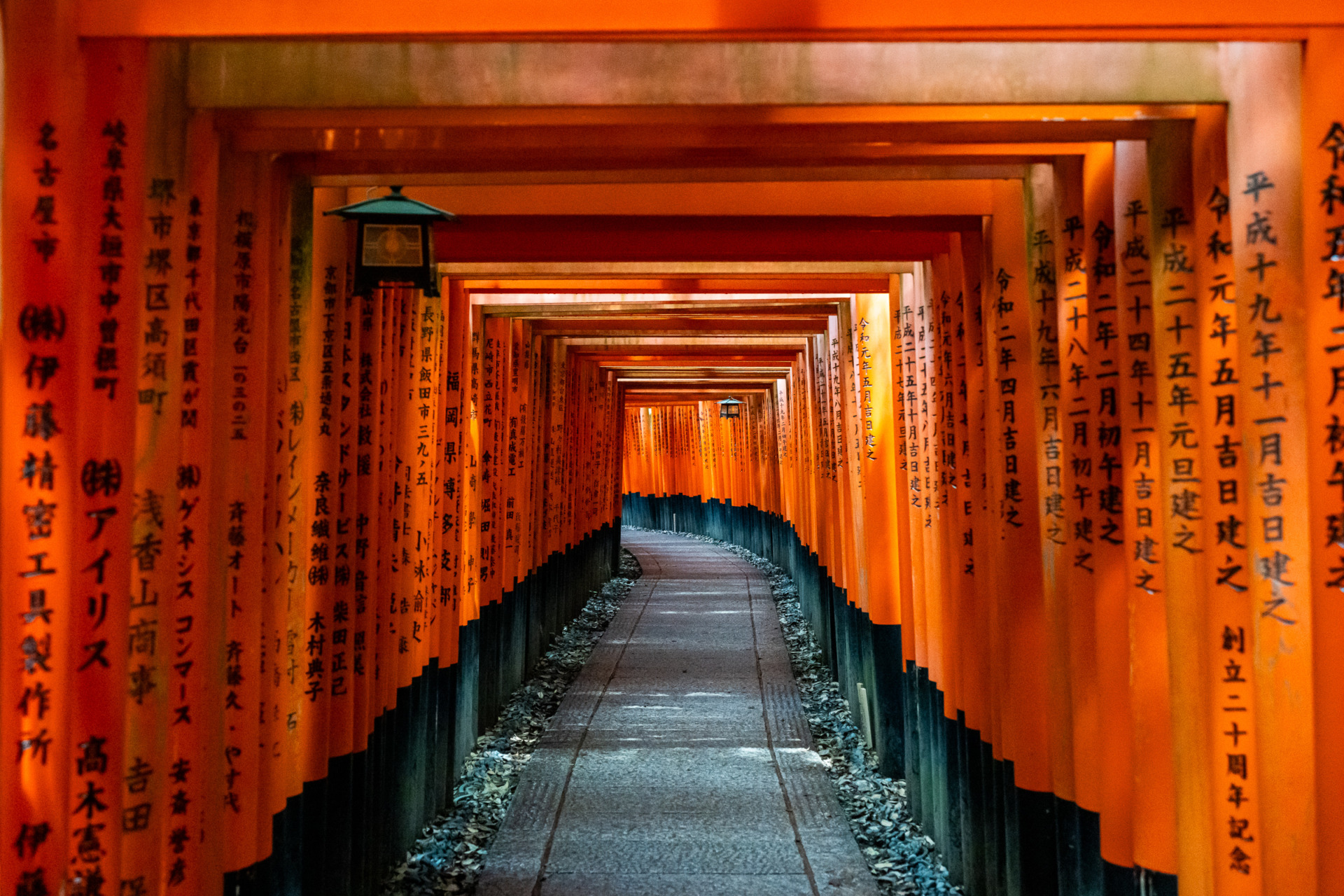Fushimi Inari Shrine: Journey Through Kyoto’s Iconic Red Gates
Welcome to the enchanting world of Fushimi Inari Shrine, an iconic destination nestled in the heart of Kyoto, Japan. A vibrant tapestry of vermilion torii gates awaits, enticing visitors on a mesmerizing journey through time and spirituality. As you step foot into this sacred space, prepare to be transported to a realm where ancient traditions come alive. Fushimi Inari Shrine, dedicated to the Shinto deity Inari, is renowned for its seemingly endless trail of red gates, leading visitors on a path that winds its way up the picturesque Mount Inari.
This article will take you on a virtual tour of Fushimi Inari Shrine, delving into its rich history, architectural marvels, and cultural significance. Whether you’re a seasoned traveler or an armchair explorer, let us guide you through the mystical allure of this spiritual sanctuary. Discover the stories behind the vibrant torii gates, soak in the serene beauty of the shrine’s surroundings, and learn about the cultural practices that have been passed down through generations. Join us as we unravel the secrets of Fushimi Inari Shrine and get ready to embark on a captivating adventure through Kyoto’s iconic red gates.
Embark on a journey like no other, as we delve into the historical, cultural, and spiritual wonders of Fushimi Inari Shrine. It’s time to immerse yourself in the beauty and mystique of this legendary destination.
History and Significance of Fushimi Inari Shrine
Fushimi Inari Shrine, established in the year 711 AD, holds a storied history that intertwines with the very essence of Shinto faith in Japan. This sacred site was originally built to honor Inari, the god of rice, agriculture, and prosperity. Over the centuries, the shrine has evolved into a crucial spiritual landmark, revered not only in Kyoto but throughout the country. The shrine’s rich history is marked by its continuous patronage from the imperial family and influential merchants, who have contributed to its development and expansion over the years.
The significance of Fushimi Inari Shrine extends beyond its historical roots; it serves as a vital cultural symbol for the Shinto religion. The shrine is dedicated to Inari, who is often depicted as a fox and is believed to be a messenger between the divine and the mortal realms. Each of the thousands of torii gates that adorn the trails leading up Mount Inari are donations from individuals and businesses, signifying their hopes for prosperity and success. This practice not only showcases the communal spirit of the shrine but also the intertwining of personal devotion and cultural heritage, making it a living testament to the faith of the Japanese people.
Visitors to the shrine will also discover numerous sub-shrines along the trails, reflecting the diverse aspects of Inari worship. Each sub-shrine possesses its own unique charm and character, contributing to the overall tapestry of the site. The rich history, combined with the continuous devotion of its patrons, makes Fushimi Inari Shrine a living monument to the enduring spirit of the Shinto faith, captivating the hearts and minds of all who venture through its gates.
Exploring the Iconic Red Gates
As you begin your journey through Fushimi Inari Shrine, the first thing that captures your attention is the stunning array of vermilion torii gates. These gates, which number in the thousands, create a captivating path that winds its way up Mount Inari, offering a breathtaking visual experience. Each gate is inscribed with the name of the donor, along with the date of the donation, serving as a reminder of the collective faith and aspirations that contribute to the shrine’s magnificence. The vibrant color of the gates, a symbol of protection and prosperity, stands in stark contrast to the lush greenery of the surrounding forest, creating a mesmerizing backdrop for visitors.
Walking through the seemingly endless corridors of torii gates, one can’t help but feel a sense of tranquility and wonder. The rhythmic sound of footsteps on the stone path, combined with the gentle rustle of leaves, creates an atmosphere that is both serene and otherworldly. The gates are arranged in a way that allows for a unique interplay of light and shadow, enhancing the mystical ambiance of the shrine. As you ascend, you may encounter various fox statues, which are believed to be the messengers of Inari. These statues, often depicted holding rice, further emphasize the deep-rooted connection between the shrine and agriculture, enriching the overall experience of this spiritual journey.
While the lower sections of the shrine are bustling with visitors, the higher trails offer a more solitary experience, allowing for moments of reflection and contemplation. The ascent can be a physically demanding one, but it is well worth the effort. Each turn reveals new vistas of Kyoto, providing breathtaking panoramic views that are truly unforgettable. The combination of natural beauty, spiritual significance, and architectural wonder makes exploring the iconic red gates of Fushimi Inari Shrine a highlight of any visit to Kyoto.
Rituals and Customs at Fushimi Inari Shrine
Fushimi Inari Shrine is not only a place of beauty; it is also a site of deep spiritual significance where various rituals and customs take place. Visitors can witness and participate in traditional Shinto practices that have been preserved over centuries. One of the most common rituals involves the offering of coins at the base of the torii gates, followed by a prayer to Inari for blessings and prosperity. This act of devotion symbolizes a connection between the worshipper and the divine, fostering a sense of community among those who visit the shrine.
Another noteworthy custom is the practice of “ema,” or wooden plaques, where visitors write their wishes or prayers and hang them at designated areas within the shrine. These ema serve as a tangible representation of hope, with many worshippers returning to check on the progress of their wishes. The act of writing and hanging an ema not only reflects personal devotion but also contributes to the rich tapestry of stories and aspirations that adorn the shrine. Additionally, the shrine hosts various festivals throughout the year, including the famous Inari Matsuri, which attracts thousands of visitors and showcases traditional performances, dances, and rituals.
Understanding these rituals and customs enhances the overall experience of visiting Fushimi Inari Shrine, allowing individuals to connect with the spiritual essence of the site. Whether you choose to participate in the offerings or simply observe from a distance, the atmosphere of reverence and devotion permeates the air, inviting all who enter to reflect on their own beliefs and aspirations. The blend of ancient practices with the modern-day pilgrimage creates a unique and enriching experience, making Fushimi Inari Shrine a living embodiment of Japanese spirituality.

Tips for Visiting Fushimi Inari Shrine
If you’re planning a visit to Fushimi Inari Shrine, there are several tips to enhance your experience and ensure a memorable journey through the iconic red gates. First and foremost, it’s advisable to start your visit early in the morning or later in the afternoon. This strategic timing allows you to beat the crowds and enjoy a more peaceful atmosphere as you navigate the trails. The soft morning light or the golden hues of sunset can also create stunning photographic opportunities, making your visit even more special.
Comfortable footwear is essential for exploring the shrine, as the trails can be steep and uneven in some areas. The hike up Mount Inari can take anywhere from 1 to 2 hours, depending on your pace and the number of stops you make along the way. Be sure to carry water and snacks to maintain your energy levels, especially during warmer months when hydration is crucial. There are resting spots along the trail, allowing you to pause, take in the views, and appreciate the serene surroundings.
While visiting the shrine, make sure to respect the customs and traditions of the site. Dress modestly and maintain a respectful demeanor, especially in sacred areas. If you choose to participate in rituals, such as offering coins or writing ema, take a moment to familiarize yourself with the customs to ensure you honor the cultural significance of these practices. Lastly, don’t rush through your visit; take the time to explore the various sub-shrines and soak in the tranquility of the environment. Each corner of Fushimi Inari Shrine holds its own unique charm waiting to be discovered.
Nearby Attractions and Activities in Kyoto
After your exploration of Fushimi Inari Shrine, consider extending your journey by visiting other nearby attractions in Kyoto. Just a short distance away is the historic Tofuku-ji Temple, renowned for its stunning Zen gardens and beautiful landscapes. The temple is particularly famous for its seasonal displays, especially during the autumn months when vibrant foliage transforms the gardens into a breathtaking spectacle of color. Tofuku-ji offers a peaceful retreat from the busyness of the city, allowing visitors to immerse themselves in the tranquility of traditional Japanese architecture and gardens.
Another must-visit destination is the Kiyomizu-dera Temple, a UNESCO World Heritage site that boasts stunning views of Kyoto from its wooden stage. The temple is famous for its cherry blossoms in spring and vibrant maple leaves in autumn, drawing visitors year-round. The surrounding streets, filled with traditional shops and tea houses, create a charming atmosphere perfect for leisurely exploration. Be sure to take a walk along the Philosopher’s Path, a picturesque canal lined with cherry trees that leads to several other temples and shrines, providing a delightful blend of nature and culture.
For those interested in immersing themselves further in Japanese culture, consider participating in a traditional tea ceremony or trying your hand at a kimono rental for a day. Many local establishments offer these experiences, allowing you to appreciate the art of tea while dressed in authentic attire. Whether you’re exploring ancient temples, enjoying local cuisine, or indulging in cultural experiences, Kyoto offers an abundance of activities that complement the majesty of Fushimi Inari Shrine.
Best Time to Visit Fushimi Inari Shrine
Choosing the best time to visit Fushimi Inari Shrine can greatly enhance your experience. Each season offers its own unique charm, making the shrine a year-round destination. Spring is particularly enchanting, as cherry blossoms bloom across Kyoto, adding a delicate touch of pink to the landscape. The contrast of the soft cherry blossoms against the vibrant red of the torii gates creates a picturesque setting that is simply breathtaking. Additionally, the mild weather during this season makes it an ideal time for hiking the trails.
Autumn is another popular time to visit, as the foliage transforms into a stunning palette of crimson, gold, and orange. The sight of the trees surrounding the shrine ablaze with color is a feast for the eyes, drawing photography enthusiasts and nature lovers alike. The cooler temperatures provide a comfortable environment for exploration, allowing visitors to fully appreciate the beauty of the shrine and its surroundings. Festivals and events are also common during these seasons, offering a glimpse into the rich cultural traditions that thrive in Kyoto.
While summer can be hot and humid, early mornings or late afternoons can still provide a pleasant experience for visitors. The lush greenery of the shrine offers shade, and the lively atmosphere during this season can be quite invigorating. Winter, though less crowded, presents its own unique allure. The tranquility of the shrine blanketed in snow creates a serene and magical ambiance that is often sought after by those looking for a peaceful retreat. Ultimately, no matter the season, Fushimi Inari Shrine promises a captivating experience that resonates with visitors from all walks of life.
How to Get to Fushimi Inari Shrine
Reaching Fushimi Inari Shrine is a straightforward process, making it easily accessible for visitors to Kyoto. The shrine is conveniently located just a short train ride from the city center. The closest station is Inari Station, which is part of the JR Nara Line. This station is situated right at the base of the shrine, allowing you to step off the train and walk directly into the enchanting world of vermilion gates. The journey from Kyoto Station typically takes around five minutes, making it a quick and convenient option for travelers.
Alternatively, visitors can choose to take the Keihan Main Line to Fushimi-Inari Station, which is also in close proximity to the shrine. This route provides another easy access point for those staying in different areas of Kyoto. Both train options are efficient, and the beautiful scenery along the way adds to the overall experience. For those who prefer a more leisurely approach, walking from the city center offers a chance to explore the local neighborhoods and experience the charm of Kyoto at a slower pace.
Once you arrive at Fushimi Inari Shrine, the well-marked paths and signage will guide you through the various trails and sub-shrines. The shrine is open year-round, and there are no entrance fees, allowing you to wander freely and immerse yourself in the spiritual atmosphere. Whether you arrive by train or on foot, the journey to Fushimi Inari Shrine is just as rewarding as the destination itself.
Fushimi Inari Shrine Souvenirs and Food
No visit to Fushimi Inari Shrine would be complete without indulging in some local delicacies and picking up unique souvenirs. As you explore the shrine grounds, you’ll find various stalls and shops selling traditional snacks and treats. One popular item is inari-zushi, a type of sushi wrapped in sweetened, marinated tofu skin, often associated with the shrine. This delicious and portable snack is perfect for enjoying while you hike the trails. Other local specialties include yaki-tori (grilled chicken skewers) and various seasonal sweets that reflect the flavors of Kyoto.
In addition to food, there are plenty of souvenir options available at the shrine. From intricate fox figurines to decorative omamori (amulets) and ema (wooden plaques), you’ll find a range of items that embody the spirit of Fushimi Inari Shrine. The fox is a significant symbol of Inari, so many visitors choose to take home a small fox statue or charm as a memento of their visit. These souvenirs serve not only as a reminder of your journey but also as a way to connect with the traditions and beliefs of the shrine.
Be sure to take the time to browse the shops and sample the local delicacies before you leave. The experience of enjoying authentic Kyoto cuisine and finding the perfect keepsake is an integral part of your visit to Fushimi Inari Shrine. These culinary delights and unique souvenirs will serve as cherished memories of your journey through this iconic destination, reminding you of the beauty and spirituality that permeates the shrine.
Final Thoughts
Fushimi Inari Shrine stands as a testament to the rich history, cultural significance, and spiritual depth that characterize Kyoto. The striking red torii gates, winding trails, and serene landscapes create an unforgettable experience for visitors, drawing them into a world where ancient traditions thrive. Through our exploration of the shrine’s history, rituals, and nearby attractions, it becomes clear that Fushimi Inari Shrine is not just a destination but a journey of self-discovery and connection to the divine.
Whether you seek spiritual enlightenment, cultural insights, or simply a beautiful place to wander, Fushimi Inari Shrine offers something for everyone. The vibrant colors of the gates, the tranquility of the forest, and the warmth of the community spirit all contribute to the allure of this iconic location. As you embark on your journey through the gates, take a moment to reflect on the stories and aspirations woven into each torii, and allow yourself to be enveloped by the magic of this sacred space.
In a world that often feels fast-paced and disconnected, Fushimi Inari Shrine serves as a reminder of the beauty of tradition, the importance of faith, and the power of community. Whether you visit during the vibrant cherry blossom season, the colorful autumn months, or the quiet serenity of winter, Fushimi Inari Shrine promises to leave a lasting impression on your heart and soul. So pack your bags, grab your camera, and get ready to immerse yourself in the enchanting world of Fushimi Inari Shrine—where every step through the iconic red gates leads to a deeper understanding of Japan’s rich cultural heritage.
Also read: Angkor Wat: Exploring Cambodia’s Ancient Wonder and Spiritual Heart


